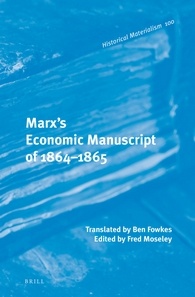Translated by Ben Fowkes. Edited and with an Introduction by Fred Moseley, Mount Holyoke College
Marx’s only full draft of Volume III of Capital was written in the Economic Manuscript of 1864—1865. The Volume III that we know was heavily edited by Engels. It has been a long-standing question in Marxian scholarship whether or not there are significant differences between Marx’s original manuscript and Engels’s edited version. Marx’s manuscript was published for the first time in German in 1992 in the Marx/Engels Gesamtausgabe, Section II, Volume 4.2, but this important manuscript has not previously been translated into English. The publication of this English translation of Marx’s original manuscript is thus an important event in Marxian scholarship. English-speaking Marxist scholars can finally compare Engels’s Volume III with Marx’s original manuscript and evaluate for themselves the significance of the differences.
Biographical note
Fred Moseley is Professor of Economics at Mount Holyoke College and is the author and editor of numerous books and articles on Marx’s theory, especially the logical method employed by Marx in Capital and the theory of the distribution of surplus-value in Volume III of Capital.
Readership
Marxian scholars around the world, and indeed anyone concerned with the heritage of Marx’s thinking, will find this newly translated volume an indispensable tool.
Table of contents
Translator’s Note
Introduction by Fred Moseley
Chapter One: The Transformation of Surplus-Value into Profit
1. Surplus-Value and Profit
[2. Cost Price]
3. Economy in the Use of Constant Capital
4. The Effect of Changes in Raw Material Prices
5. Release and Tying-up of Capital, Depreciation and Appreciation, Revaluation and Devaluation of Capital
6. The Influence of Changes in Circulation Time, its Shortening or Lengthening (and also changes in the means of communication connected with this) on the Rate of Profit
7. Profit (as it appears to the bourgeois)
Chapter Two: The Transformation of Profit into Average Profit
1. Different Compositions of Capital in Different Branches of Production and the Resulting Variation in Rates of Profit
2. Formation of a General Rate of Profit (Average Profit) and Transformation of Commodity Values into Prices of Production
3. The Equalisation of the General Rate of Profit through Competition. Market Prices and Market Values. Surplus Profit.
4. The Effects of a General Increase or Reduction (Fall) in Wages on the Prices of Production of the Different Commodities
5. The Capitalist’s Grounds for Compensation Supplement on Prices of Production
Chapter Three: The Law of the Tendential Fall in the General Rate of Profit with the Advance of Capitalist Production
Chapter Four: The Transformation of Commodity Capital and Money Capital into Merchant’s Capital (Commodity-Dealing Capital and Money-Dealing Capital)
1. Commodity-Dealing Capital (Commercial Profit)
2. Commercial Profit and its Characteristics
3. The Turnover of Mercantile Capital. Prices
4. Money-Dealing Capital
5. [no title]
Chapter Five: The Division of Profit into Interest and Profit of Enterprise. (Industrial or Commercial Profit). Interest-Bearing Capital
1. [Interest-Bearing Capital]
2. Division of Profit. Rate of Interest. The Natural Rate of Interest
3. Interest and Profit of Enterprise
4. The Externalisation of Surplus-Value and the Capital Relation in General in the Form of Interest-Bearing Capital
5. Credit. Fictitious Capital
6. Pre-Bourgeois Relations
Chapter Six: The Transformation of Surplus Profit into Ground-Rent
(a) Introduction
(c) Absolute Ground-Rent
(b) Differential Rent
[The First Form of Differential Rent]
[The Second Form of Differential Rent]
Chapter Seven: The Revenues and their Sources
1. The Trinity Formula
2. [On the Analysis of the Production Process]
3. The Illusion Created by Competition
4. Relations of Production and Distribution
5. Classes
Appendix
Bibliography
Index

